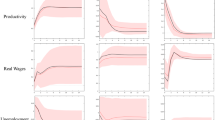Abstract
Current thinking on the causes of Europe’s persistent unemployment problem does not accord much weight to open-economy considerations. While there is agreement that the high unemployment of the 1980s reflects an increased level in the non-accelerating inflation rate of unemployment (NAIRU), it is equally clear that the increase recorded since 1980 cannot plausibly be attributed to the same kind of unfavourable supply shocks, including terms-of-trade shocks, which are widely seen as the major cause of rising unemployment in the 1970s (see Blanchard and Summers, 1986). Most recent explanations rely on one variant or another of hysteresis, that is, on the idea that a high equilibrium rate of unemployment may simply reflect a past history of high actual unemployment.
The authors are grateful to Søren Bo Nielsen, discussant and the participants of the Conference for their helpful comments.
Access this chapter
Tax calculation will be finalised at checkout
Purchases are for personal use only
Preview
Unable to display preview. Download preview PDF.
Similar content being viewed by others
References
Bean, C. (1989) ‘Capital Shortages and Persistent Unemployment’, Economic Policy, vol. 8.
Blanchard, O. (1990) ‘Unemployment: Getting the Question Right — and Some of the Answers’, in J. Drèze and C. Bean (eds.) Europe’s Unemployment Problem (Cambridge: Cambridge University Press).
Blanchard, O. and Summers, L. (1986) ‘Hysteresis and the European Unemployment Problem’, NBER Macroeconomics Annual 1986.
Blanchard, O. and Fischer, S. (1989) Lectures on Macroeconomics (Cambridge: Cambridge University Press).
Burda, M. (1988) ‘Is There a Capital Shortage in Europe?’, Weltwirtschaftliches Archiv, vol. 124.
Calmfors, L. and Nymoen, R. (1990) ‘Real Wage Adjustment and Employment Policies in the Nordic Countries’, Economic Policy, no. 11.
Dornbusch, R. (1983) ‘Flexible Exchange Rates and Interdependence’, IMF Staff Papers, vol. 30.
Feldstein, M. and Horioka, C. (1980) ‘Domestic Saving and International Capital Flows’, Economic Journal, vol. 90.
Fitoussi, J.-P. and Phelps, E.S. (1988) The Slump in Europe (Oxford: Basil Blackwell).
Franz, W. (1984) ‘Wohin treibt die Phillipskurve?’, Zeitschrift für Wirtschafts-und Sozialwissenschaften, vol. 104.
Franz, W. (1987) ‘Hysteresis, Persistence, and the NAIRU: An Empirical Analysis for the Federal Republic of Germany’, in Layard, R. and Calmfors, L. (eds), The Fight Against Unemployment (Cambridge: Cambridge University Press).
Gordon, R. (1988) ‘Back to the Future: European Unemployment Today Viewed from America in 1939’, Brookings Papers on Economic Activity, no. 1.
Hellwig, M. and Neumann, M. (1987) ‘Economic Policy in Germany: Was There a Turnaround?’, Economic Policy, no. 5.
Krugman, P. (1987)’ slow Growth in Europe: Conceptual Issues’, in Lawrence, R. and Schultze, C. (eds), Barriers to European Growth (Washington).
Landmann, O. and Jerger, J. (1991) ‘Domestic Wage Shocks, Foreign Interest Rate Shocks and the Wage Gap in an Open Economy: The Case of Germany’, Diskussionspapier des Instituts für allgemeine Wirtschaftsforschung der Universität Freiburg, April 1991.
Layard, R. and Bean, C. (1989) ‘Why Does Unemployment Persist?’, Scandinavian Journal of Economics, vol. 91.
McCallum, J. (1985) ‘Wage Gaps, Factor Shares and Real Wages’, Scandinavian Journal of Economics, vol. 87.
OECD (1988) Economic Surveys — Germany, 1987/88, Paris.
Phelps, E. (1989) ‘New Channels in the Transmission of Foreign Shocks’, in Calvo, G. et al. (eds), Debt, Stabilization and Development (Oxford: Oxford University Press).
Sachs, J. (1979) ‘Wages, Profits, and Macroeconomic Adjustment: A comparative Study’, Brookings Papers on Economic Activity, no. 2.
Sachs, J. (1980) ‘Wages, Flexible Exchange Rates, and Macroeconomic Policy’, Quarterly Journal of Economics, vol. 94.
Sachs, J. (1981) ‘The Current Account and Macroeconomic Adjustment in the 1970s’, Brookings Papers on Economic Activity, no. 1.
Schultze, C. (1987) ‘Real Wages, Real Wage Aspirations, and Unemployment in Europe’, in Lawrence, R. and Schultze, C. (eds), Barriers to European Growth (Washington).
Solow, R. (1986) ‘Unemployment: Getting the Questions Right’, Economica, vol. 53 (supplement).
Author information
Authors and Affiliations
Editor information
Editors and Affiliations
Copyright information
© 1993 International Economic Association
About this chapter
Cite this chapter
Landmann, O., Jerger, J. (1993). Domestic and Foreign Shocks to Employment and Capital Accumulation in Germany. In: Frisch, H., Wörgötter, A. (eds) Open-Economy Macroeconomics. International Economic Association Series. Palgrave Macmillan, London. https://doi.org/10.1007/978-1-349-12884-6_10
Download citation
DOI: https://doi.org/10.1007/978-1-349-12884-6_10
Publisher Name: Palgrave Macmillan, London
Print ISBN: 978-1-349-12886-0
Online ISBN: 978-1-349-12884-6
eBook Packages: Palgrave Economics & Finance CollectionEconomics and Finance (R0)




